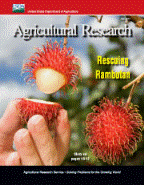United States Department of Agriculture: Agricultural Research Service, Lincoln, Nebraska

Agricultural Research Magazine
Date of this Version
5-2013
Document Type
Article
Citation
Agricultural Research May/June 2013.
Abstract
There's a lot that can be done with a corn cob after the kernels have been removed. Farmers leave the cobs on the field to boost soil quality. Enterprising cooks use the cobs to make jelly. In China, the sugar xylose is extracted from the cob for industrial uses.
Liu worked with technician Scott Weber and supervisory microbiologist Michael Cotta on this project. All three researchers are in the Bioenergy Research Unit at the National Center for Agricultural Utilization Research in Peoria, Illinois.
The team started the project with a strain of yeast that had been identified in earlier studies on the use of sweet sorghum as a biofeedstock for ethanol production. Then, in the laboratory, they placed this strain in environments that would promote the expression of genetic traits that favor SSF, including adapting to higher temperatures and tolerating cob-derived compounds that interfere with ethanol production. This resulted in the selection of Y-50464.
The team compared how quickly Y-50464 and another yeast strain, Y-12632, could release and ferment the sugar in corn cob residues after the xylose had been extracted. Liu’s star newcomer yeast was able to grow and reach its highest cell density in less than 24 hours after the test began. The comparison yeast didn’t grow at all.
Included in
Agriculture Commons, Animal Sciences Commons, Food Science Commons, Plant Sciences Commons

